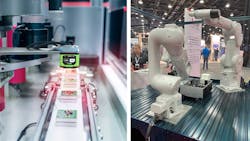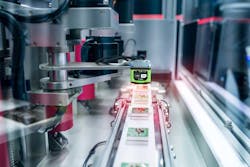Automate 2022: Machine Vision Solutions Point to the Future of Automation
At a Glance:
- Alex Shikany, vice president, Membership & Business Intelligence, A3, puts a spotlight on the robotics industry’s biggest trends and notable statistics.
- The robotics industry is seeing historic levels of adoption and technology convergence plays a big part in its growth.
- Exhibitors at Automate demonstrate how machine vision portfolios integrate technologies that enable complete automation.
Technological research firm Gartner uses the word “hyperautomation” to describe a strategic technology trend in which end-to-end automation can be used to transform a business. The term could also apply to the level of disruption displayed at Automate 2022, where exhibitors demonstrated how integrating multiple technologies and platforms are collaborating to scale automation across enterprises.
After a couple of years of lockdowns and trade show cancellations, the bi-annual event hosted by the Association for Advancing Automation (A3) was a veritable block party for many of the world’s leading global suppliers. More than 600 robotics and automation exhibitors congregated at Huntington Place in Detroit (June 6-9, 2022) to share the latest innovations and best practices in machine vision, motion control, artificial intelligence and robotic process automation.
“Coming out of the pandemic, companies in every industry will be looking for automation products and solutions to help them become more successful in an increasingly-automated world,” A3 president, Jeff Burnstein, said in a pre-event note to the press.
Alex Shikany, A3’s vice president of membership and business intelligence, agreed. The industry has reached historic levels of not only technology adoption but also technology convergence, he pointed out during an industry trends and outlook presentation. With 11,595 robots sold at a value of $646 million, he said, North American companies purchased “the most robots ever” in a single quarter.
“Every industry, including agriculture, construction, retail and hospitality, is now looking at how they can take advantage of robotics to make their companies more successful,” Shikany said.
A3 data showed that while automotive orders remained strong in Q1 of 2022, non-automotive companies are driving the increase in orders overall. During this period, unit sales to automotive OEMs were up 15% while orders from automotive component companies were up 22%.
The data also revealed that non-automotive industries such as metals, warehousing and life sciences—which previously had not deployed automation—currently display “deep levels of automation deployment,” Shikany added.
According to A3 data, unit sales to non-automotive industries saw increases in Q1 over the same period of 2021. The data revealed that:
- Metals were up 40%;
- Plastics and Rubber were up 29%;
- Semiconductors and Electronics/Photonics were up 23%;
- Food and Consumer Goods were up 21%;
- Life Sciences/Pharma/Biomed were up 14%; and
- All Other Industries were up 56%.
Robotic adoption has undergone a historical shift, too. In 2011 the automotive industry held 64% market share, while non-auto held 36%. In 2021, the trend has reversed; the non-auto segment of industry held 58% of market share. The trend first saw a reversal in 2020, pointed out Shikany.
“It’s just an incredible time that’s indicative of all the new applications and industries that are represented at the show,” he said. “When you walk through the booths, you see motion control, you see robotics and vision solutions come together. Whether you’re coming at it from an investment perspective or deployment perspective, it is all working together.”
Line of Sight
A key insight from Shikany’s analysis was that machine vision portfolios have been a major factor in the way manufacturers achieve automation milestones. The market segment made record gains in 2021. “The annual numbers surpassed $3 billion in North America for the first time on record and indications for the first quarter was strong as well,” Shikany said.
The ever-expanding application base for industrial machine vision technology was apparent in exhibitors’ cross-sector applications and were also reflected in presentation topics and certification programs tailored to advance attendees’ knowledge as Certified Vision Professionals.
From image sensors with higher resolution and faster frame rates, to optics for nonvisible wavelengths and better components for communication protocols, machine builders, integrators and vision developers were on the lookout for form factors that support high reliability, stability and accuracy. What follows is a sampling among a multitude of components and applications on display at this year’s show.
A Nod to Fixed Industrial Scanners
Zebra Technologies’ fixed industrial scanners and machine vision systems were recognized among the best in machine vision by the judges of the Vision Systems Design 2022 Innovators Awards program. Zebra, which recently acquired Matrox Imaging, brought its first suite of machine vision cameras and fixed industrial scanners to market in 2021.
These systems are powered by the Zebra Aurora software platform, an interface that integrates with factory and warehouse systems. The in-motion vision scan functionality is touted for enabling warehouse workers, AMRs, fixed industrial scanners and machine vision systems to decrease material transport tasks by up to 50%.
Reliable Detection
SensoPart is a specialist in the detection, positioning, identification and recognition of measuring colours and contrast. SensoPart’s booth demonstrations were set up to show how photoelectric sensors with BlueLight technology can offer greater detection efficiency than conventional red light proximity sensors, particularly when detecting dark or transparent objects, including black objects with a high gloss surface.
With detection rates of 2 mm to 1,200 mm and with a protection degree of up to IP69K, the solution can be used in the automotive, plastics, packaging and pharmaceuticals industries. The hardware is complemented by VISOR software, allowing applications to be up and running and continuously monitored.
Collaboration is Key
Mitsubishi Electric Automation’s “better together” theme and in-booth experience included not only a glimpse of its robots and automation, but also ways in which solutions can be integrated. During a booth visit, Patrick Varley, product marketing manager for Mechatronics at Mitsubishi Electric Automation, highlighted the collaborative effort between Realtime Robotics RapidPlan robot programming and motion control software and Mitsubishi Electric’s industrial robots in a demo cell.
Two robots (RV-7FRL and RV-8CRL) simulated their ability to move to various focal points on a workpiece, while the ASSISTA collaborative robot worked around them to inspect various points of interest. Varley pointed out that in real-world settings, the time spent programming and re-programming industrial robots can take up too much of an engineer’s time.
“Realtime Robotics’ technology has the ability to speed deployment, operations and production for manufacturers, helping to improve their cost structures and time-to-market,” said Varley.
Eye of Production
A long-time supporter of Automate, MVTec Software made its presence known by displaying the company’s comprehensive machine vision software product portfolio in a larger booth. In addition to rolling out two new software versions—HALCON 22.05 and MERLIC 5.1—the software company emphasized how its service offerings in application evaluations, training documentation and technical support can be efficiently integrated into customers’ applications.
In one demo, experts demonstrated how common bar and data codes can be read using MVTec’s software, regardless of orientation and even when the element width was less than one pixel or when the code was partially obscured.
Quality Inspections
Teledyne Technologies showcased its range of its digital imaging products, instrumentation and engineered systems. One of its business units, Teledyne DALSA, demonstrated the Z-Trak 2, configured for 360-deg. in-line inspection and measurement. The 3D image sensor technology can deliver scan speeds of up to 45,000 profiles/sec. and can be used in discrete applications, as well as for continuous extrusion, or outdoor applications such as roads and highways.
The company noted that sensors housed in IP67 enclosures were designed for harsh environments. The instrument is bundled free with Teledyne Imaging’s Sherlock 8.1—a point-and-click, rapid application development software package, Sapera Processing RTLs (real-time locating systems) and Sapera LT, a free image acquisition and control software development toolkit.
The Big Picture
What does all of this mean? Automation technology (hardware and software) has in recent years been deployed in record numbers and at historic rates of adoption. For Shikany, the upshot is that alongside the evolving sensing and navigation functionality of robotic systems, the convergence of complex machine vision systems, imaging capabilities and algorithms will continue to play a fundamental role in driving the automation tools that make companies of all sizes more productive.
About the Author

Rehana Begg
Editor-in-Chief, Machine Design
As Machine Design’s content lead, Rehana Begg is tasked with elevating the voice of the design and multi-disciplinary engineer in the face of digital transformation and engineering innovation. Begg has more than 24 years of editorial experience and has spent the past decade in the trenches of industrial manufacturing, focusing on new technologies, manufacturing innovation and business. Her B2B career has taken her from corporate boardrooms to plant floors and underground mining stopes, covering everything from automation & IIoT, robotics, mechanical design and additive manufacturing to plant operations, maintenance, reliability and continuous improvement. Begg holds an MBA, a Master of Journalism degree, and a BA (Hons.) in Political Science. She is committed to lifelong learning and feeds her passion for innovation in publishing, transparent science and clear communication by attending relevant conferences and seminars/workshops.
Follow Rehana Begg via the following social media handles:
X: @rehanabegg
LinkedIn: @rehanabegg and @MachineDesign



